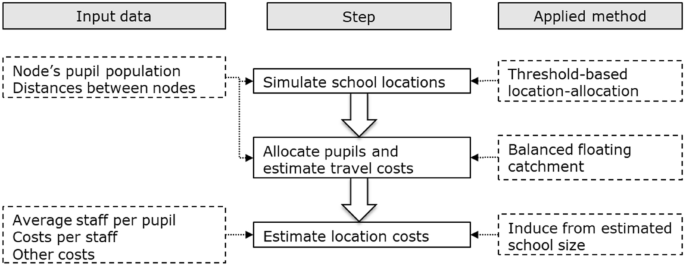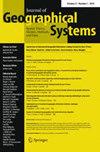Estimating school provision, access and costs from local pupil counts under decentralised governance
IF 2.8
3区 地球科学
Q1 GEOGRAPHY
引用次数: 0
Abstract
Abstract This study proposes a sequence of methods to obtain geolocated estimates of primary school provision, costs, and access. This sequence entails: (1) location-allocation, an approach that mimics school location patterns in case of decentralised governance, such as exists in the EU and UK; (2) balanced floating catchment areas, an approach to assign pupils to schools assuming free school choice; and (3) school costs estimates, which are induced from pupil counts and the distributional properties of observed school costs. The method is fine-tuned using observed school locations and school-level costs data. It is developed to assess how much local population densities and demography affects school access and schooling costs across Europe. Its results can be aggregated by degree of urbanisation to quantify the differences across human settlements ranging from mostly uninhabited areas to densely populated cities.

在分权管理下,根据当地学生人数估算学校供应、入学机会和成本
摘要:本研究提出了一系列方法,以获得小学提供,成本和获取的地理估计。这个顺序需要:(1)地点分配,这是一种在分散治理的情况下模仿学校位置模式的方法,例如欧盟和英国;(2)平衡浮动集水区,将学生分配到自由择校的学校;(3)学校成本估算,这是由学生数量和观察到的学校成本的分布特性得出的。该方法使用观察到的学校位置和学校级别的成本数据进行微调。它的开发是为了评估欧洲各地的当地人口密度和人口统计对学校入学和教育成本的影响程度。它的结果可以按城市化程度汇总,以量化人类住区之间的差异,从大多数无人居住的地区到人口密集的城市。
本文章由计算机程序翻译,如有差异,请以英文原文为准。
求助全文
约1分钟内获得全文
求助全文
来源期刊

Journal of Geographical Systems
GEOGRAPHY-
CiteScore
5.40
自引率
6.90%
发文量
33
期刊介绍:
The Journal of Geographical Systems (JGS) is an interdisciplinary peer-reviewed academic journal that aims to encourage and promote high-quality scholarship on new theoretical or empirical results, models and methods in the social sciences. It solicits original papers with a spatial dimension that can be of interest to social scientists. Coverage includes regional science, economic geography, spatial economics, regional and urban economics, GIScience and GeoComputation, big data and machine learning. Spatial analysis, spatial econometrics and statistics are strongly represented.
One of the distinctive features of the journal is its concern for the interface between modeling, statistical techniques and spatial issues in a wide spectrum of related fields. An important goal of the journal is to encourage a spatial perspective in the social sciences that emphasizes geographical space as a relevant dimension to our understanding of socio-economic phenomena.
Contributions should be of high-quality, be technically well-crafted, make a substantial contribution to the subject and contain a spatial dimension. The journal also aims to publish, review and survey articles that make recent theoretical and methodological developments more readily accessible to the audience of the journal.
All papers of this journal have undergone rigorous double-blind peer-review, based on initial editor screening and with at least two peer reviewers.
Officially cited as J Geogr Syst
 求助内容:
求助内容: 应助结果提醒方式:
应助结果提醒方式:


